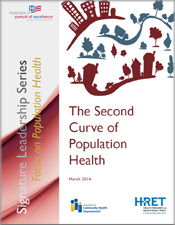Resource:
The Second Curve of Population Health
The tactics described in this guide provide a framework for initiatives that hospitals and care systems could pursue to develop an institutional infrastructure that supports population health.
As hospitals and care systems transform, they are increasingly prioritizing population health as a platform to improve the health of patients and communities. Myriad forces are driving these health care organizations to actively address a broad array of socioeconomic and environmental factors and provide preventive care, particularly for populations who lack access to care or engage the system at the wrong place and time. Building on health care futurist Ian Morrison’s idea of health care transformation as a shift from a fee-for-service first curve to a value-based second curve, the second curve of population health depicts an integrated approach to improving patient and community health. For many hospitals, thriving in the second-curve environment will necessitate making challenging organizational and cultural changes to support new goals and initiatives.
This guide builds upon prior American Hospital Association reports that outline a road map for hospitals and care systems to use as they transition to the second curve of population health. Though the rate and extent to which hospitals and care systems engage in population health initiatives may vary, a significant shift toward population health is anticipated in the next three to five years. The tactics described in this guide provide a framework for initiatives that hospitals and care systems could pursue to develop an institutional infrastructure that supports population health. These tactics are:
- Value-based reimbursement
- Seamless care across all settings
- Proactive and systematic patient education
- Workplace competencies and education on population health
- Integrated, comprehensive HIT that supports risk stratification of patients with real-time accessibility
Mature community partnerships to collaborate on community-based solutions Hospitals and care systems transitioning to the second curve of population health evaluate process and outcomes metrics to measure their progress in improving patient and community health. Aligning the needs and assets of the hospital and community with metrics allows for meaningful and significant analysis. Possible metrics include but are not limited to:
- Summary measures
- Inequality measures
- Health status
- Psychological state
- Ability to function
- Access to health care
- Clinical preventive services
- Cost of care
As established community stakeholders with extensive knowledge and resources, hospitals are in a unique position to lead population health transformation. Hospitals should challenge themselves to reach beyond their walls and partner with community organizations to implement innovative approaches that sustainably improve total population health.
